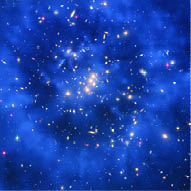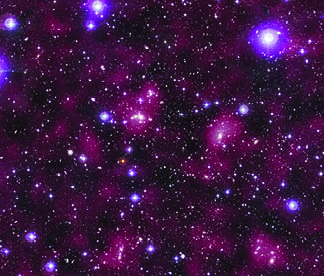
Editor’s note: Every year the Does God Exist? ministry gives $1000 scholarships to anyone planning to go on to higher education. The basis of the awarding of the scholarship is an essay that is written on the compatibility of science and faith in God. The winner of the fall scholarship in 2009 was incarcerated and yet was able to write an excellent essay. We hope you enjoy his insights which fit the theme of this issue.
“In the beginning God created the heaven and the earth” (Genesis 1:1). Nothing in this world can cause more conflict between the scientific and religious communities than this one verse of Scripture. For atheists in the scientific community this verse is nothing more  than primitive man’s feeble attempt to explain how the universe came into existence. For the religious community this verse is God’s declaration that he exists and that he created the universe. Some in both the scientific and religious communities have become dogmatic in their belief of how the universe came into existence and are unwilling to put their egos aside and discuss the topic. As far as they are concerned, science and the Bible are mortal enemies. But nothing can be farther from the truth. While the Bible is not a scientific textbook, it is not a mortal enemy of science. In fact, science and the Bible are compatible, especially concerning how the universe came into existence.
than primitive man’s feeble attempt to explain how the universe came into existence. For the religious community this verse is God’s declaration that he exists and that he created the universe. Some in both the scientific and religious communities have become dogmatic in their belief of how the universe came into existence and are unwilling to put their egos aside and discuss the topic. As far as they are concerned, science and the Bible are mortal enemies. But nothing can be farther from the truth. While the Bible is not a scientific textbook, it is not a mortal enemy of science. In fact, science and the Bible are compatible, especially concerning how the universe came into existence.
“In the beginning God created the heaven and the earth.” In this verse we are told that God created the universe sometime in the distant past, not how he created the universe. Or is there more to this verse than the English translation gives? In the original language of the Old Testament Hebrew, the word translated as “created” is bara. Bara means to create something from nothing, from that which did not exist. This verb is only used with “God” as its subject. Only God can create in the sense implied by bara. The verb expresses creation on a cosmic scale: “In the beginning God created the heaven and the earth” (Genesis 1:1; cf. Genesis 2:3; Isaiah 40:26; 42:5).1 This is further supported by Hebrews 11:3 which states, “Through faith we understand that the worlds were framed by the word of God, so that things which are seen were not made of things which do appear.” This verse, along with Isaiah 45:12, 18; John 1:3; and Colossians 1:15 – 17, indicates that the source of the universe is God, that there is a beginning to the universe, and that it was created out of nothing — ex nihilo. All of this raises the question, “How does this agree with science?”
Scientists tell us that approximately 14 billion years ago the universe was created when an explosion, called a singularity, took place. This is known as the big bang theory. According to science this “great outward explosion of [matter/energy] at the ‘big bang’ was a factory of creation.”2 From this explosion of matter/energy the universe expanded into all that we see today. Yet, “if the universe did in fact begin in a hot big bang, debris (both matter and radiation) from that explosion should now lie all around us. The matter is pretty obvious: you can now see planets, stars, and galaxies, and the unformed matter of interstellar gas and dust among all of these.”3 The big bang theory is further supported by the discovery of cosmic background radiation as well as the expansion of the universe.

Evidence of a cosmic explosion was discovered by two men from Bell Laboratories, Arno Penzias and Robert Wilson. In 1965 they found “cosmic microwave background radiation everywhere, filling all space.”4 An explosion on the cosmic scale would leave residual radiation and this background radiation that is so evenly dispersed throughout the universe is probably the most important evidence of the hot big bang.
The expansion of the universe is also evidenced by the Doppler effect. The first Doppler shift was measured by Vesto M. Slipher in 1912. Between 1912 and 1945 he observed 41 galaxies and “all but three exhibited redshifts in their spectra.”5 By observing these redshifts he was able to ascertain that the galaxies are moving away from us. Scientists have also been able to determine that the galaxies are all moving away from each other. Furthermore, the more distant galaxies have a greater redshift which indicates that they are moving faster than nearer galaxies. This information now raises the question, “How does this agree with the Bible?”
 The Bible has stated for over 3,500 years what scientists have just recently learned — that the universe is not static, but is actually expanding. This can be seen by following one of the basic rules when reading the Bible — Scripture interprets Scripture. With this said, when reading Genesis 1:1 there is one word that we must look at and compare its usage throughout the Bible. The word is shamayim, which is translated as “heaven” in Genesis 1:1 and is used in reference to the universe. It is used eleven times in the Bible in connection with another Hebrew word, natah, which means “to stretch forth, spread out, stretch down, turn aside … This verb may also mean ‘to extend’ in every direction … This act and its result is a figure of God’s creating the heavens”6 (cf. Job 9:8; Psalm 104:2; Isaiah 40:22; 42:5; 44:24; 45:12; 48:13; 51:13; Jeremiah 10:12; 51:15; and Zechariah 12:1). When the noun shamayim is used with the verb natah it is used to denote a continuous action. This usage of shamayim with natah indicates that the universe is not static, but is expanding.
The Bible has stated for over 3,500 years what scientists have just recently learned — that the universe is not static, but is actually expanding. This can be seen by following one of the basic rules when reading the Bible — Scripture interprets Scripture. With this said, when reading Genesis 1:1 there is one word that we must look at and compare its usage throughout the Bible. The word is shamayim, which is translated as “heaven” in Genesis 1:1 and is used in reference to the universe. It is used eleven times in the Bible in connection with another Hebrew word, natah, which means “to stretch forth, spread out, stretch down, turn aside … This verb may also mean ‘to extend’ in every direction … This act and its result is a figure of God’s creating the heavens”6 (cf. Job 9:8; Psalm 104:2; Isaiah 40:22; 42:5; 44:24; 45:12; 48:13; 51:13; Jeremiah 10:12; 51:15; and Zechariah 12:1). When the noun shamayim is used with the verb natah it is used to denote a continuous action. This usage of shamayim with natah indicates that the universe is not static, but is expanding.
 Science and the Bible, mortal enemies or allies? I believe that the evidence supports allies. While the Bible is not a scientific textbook it does agree with science concerning the creation of the universe. The Bible states that there was a beginning — so does science. The Bible states that the universe was created out of nothing — so does science. The Bible states that the universe is not static but is in fact continuously expanding — so does science.
Science and the Bible, mortal enemies or allies? I believe that the evidence supports allies. While the Bible is not a scientific textbook it does agree with science concerning the creation of the universe. The Bible states that there was a beginning — so does science. The Bible states that the universe was created out of nothing — so does science. The Bible states that the universe is not static but is in fact continuously expanding — so does science.
Despite this evidence many refuse to believe that the Bible and science are compatible and are actually allies. Science is the search for truth and knowledge. The Bible supports this search for truth and knowledge. Proverbs 3:13 states, “Happy is the man that findeth wisdom, and the man that getteth understanding.” Is it not amazing that as we search for truth and knowledge we are always being led back to God?
Notes
1. W.E. Vine, Merrill F. Unger, and William White, Jr., Vine’s Complete Expository Dictionary of Old and New Testament Words, (Nashville: Thomas Nelson Publishers, 1996), 51.
2. Richard Fortey, LIFE: A Natural History of the First Four Billion Years of Life on Earth, (New York: Vintage Books, 1997), 27.
3. Michael Zeilik, Astronomy: The Evolving Universe, (New York: John Wiley & Sons Inc., 1994), 484.
4. James B. Kaler, Astronomy, (New York: Harper Collins Publishing, 1994), 523.
5. Ibid., 492.
6. W.E. Vine, Merrill F. Unger, and William White, Jr., Vine’s Complete Expository Dictionary of Old and New Testament Words, (Nashville: Thomas Nelson Publishers, 1996), 248-249.
Picture captions — 3rd from top to bottom:
Cluster of galaxies with a ring of dark matter.
Dark matter distribution in supercluster Abell 901/902.
Picture credits:
©xdrew. Image from BigStockPhoto.com
Roland Earnst from BigStockPhoto.com
NASA, ESA, Lee & Ford
NASA, ESA, Heymans, Gray, Wolf & Meisenheimer
